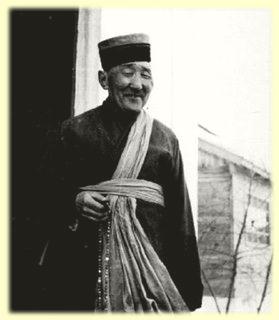| Buddhist celebrations
are introduced by a gong. The priest told me about their most important
festival which they celebrate 24th to 26th February. He said: "We celebrate
it in the honour of the Buddha and his enlightenment and for the welfare
of the whole world". They recite old Buddhist texts in Tibetan as well
as in their own language.
I asked the priest to put on his religious vestment, a kind of orange-coloured gown with the yellow scarf and cap of the same colour. Willingly he gave me permission to take photographs of him and of the interior of the building. I observed that the Buddhist
Kalmyks of Belgrade practised the virtues of kindness, helpfulness, tolerance
and modesty. At the end of World War II the Russians invaded Yugoslavia and the Kalmyks, who preferred deserting their homes again to abandoning their religion and freedom, were again obliged to flee westward. They lived more than six years in camps for Displaced Persons near Munich. Even in these camps they established their temple in a special room with all the pictures and precious things which they had saved from Belgrade. Overcrowded West Germany could not offer them adequate living conditions, therefore they applied to many western countries for immigration. I have heard that some of the Kalmyks have immigrated to the USA and Canada and others to France and Belgium. It is pity that this ethnological group of about 700 Kalmyks is now dispersed over so many countries. |
 Moreover,
they are not 'intellectually interested in Buddhism' as are so many Westerners;
they have been Buddhist for centuries and they want to continue so.
Moreover,
they are not 'intellectually interested in Buddhism' as are so many Westerners;
they have been Buddhist for centuries and they want to continue so.